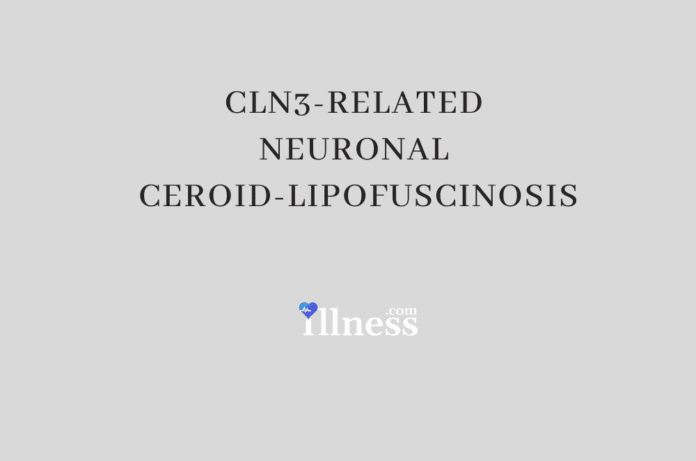Overview Of CLN3-Related Neuronal Ceroid-Lipofuscinosis
CLN3-related neuronal ceroid-lipofuscinosis is an inherited disorder that primarily affects the nervous system. After 4 to 6 years of normal development, children with this condition develop vision impairment, intellectual disability, movement problems, speech difficulties, and seizures, which worsen over time.
In children with CLN3-related neuronal ceroid-lipofuscinosis, problems with vision often begin between the ages of 4 and 8 years. Vision impairment is caused by a breakdown of the light-sensitive tissue at the back of the eye (retinal degeneration), which worsens with age. People with this disease are often blind by late childhood or adolescence. Also around age 4 to 8, children with CLN3-related neuronal ceroid-lipofuscinosis start to fall behind in school. They have difficulty learning new information and lose previously acquired skills (developmental regression), usually beginning with a loss of the ability to speak in complete sentences.
Seizures and movement abnormalities often develop in adolescence in people with CLN3-related neuronal ceroid-lipofuscinosis. These abnormalities include muscle rigidity or stiffness, clumsiness, slow or diminished movements (hypokinesia), and a stooped posture. Over time, affected individuals lose the ability to walk or sit independently and require wheelchair assistance. Rarely, people with CLN3 disease develop a distorted view of reality (psychosis) or false perceptions (hallucinations). Some affected individuals have an abnormal heart rhythm (arrhythmia) later in life. Most people with this disease live into early adulthood.
CLN3-related neuronal ceroid-lipofuscinosis is one of a group of disorders known as neuronal ceroid lipofuscinoses (NCLs), which may also be collectively referred to as Batten disease. All these disorders affect the nervous system and typically cause worsening problems with vision, movement, and thinking ability. The different NCLs are distinguished by their genetic cause. Each disease type is given the designation “CLN,” meaning ceroid lipofuscinosis, neuronal, and then a number to indicate its subtype.
Commonly Associated With CLN3-Related Neuronal Ceroid-Lipofuscinosis
- Batten-Mayou disease
- Batten-Spielmeyer-Vogt disease
- juvenile Batten disease
- juvenile cerebroretinal degeneration
- juvenile neuronal ceroid lipofuscinosis
- Spielmeyer-Vogt disease
Causes Of CLN3-Related Neuronal Ceroid-Lipofuscinosis
CLN3-related neuronal ceroid-lipofuscinosis is caused by mutations in the CLN3 gene, which provides instructions for making a protein that is found in tissues throughout the body. The CLN3 protein is part of many compartments within cells, including lysosomes, which are cellular compartments that digest and recycle different types of molecules. However, the exact function of the CLN3 protein is unclear. Research has shown that this protein is involved in many cellular processes, but it is uncertain which of them is the primary role of the protein, or if these processes instead represent downstream effects.
It is unclear how mutations in the CLN3 gene lead to the characteristic features of CLN3 disease. One CLN3 gene mutation, found in the vast majority of cases, leads to the production of an abnormally short protein. As a result, the abnormal CLN3 protein is broken down or may interfere with normal cellular processes. Other mutations reduce the amount of normal protein or impair its function. It is not known how the loss of this protein causes the signs and symptoms of CLN3 disease.
CLN3-related neuronal ceroid-lipofuscinosis, like other NCLs, is characterized by the accumulation of proteins and other substances in lysosomes. These accumulations occur in cells throughout the body; however, nerve cells seem to be particularly vulnerable to their effects. The accumulations can cause cell damage leading to cell death. The progressive death of nerve cells in the brain and other tissues leads to the neurological signs and symptoms of CLN3 disease. However, it is unclear how mutations in the CLN3 gene are involved in the buildup of substances in lysosomes.
Other
CLN3-related neuronal ceroid-lipofuscinosis is the most common type of NCL, but its exact prevalence is unknown; more than 400 cases have been described in the scientific literature. Collectively, all forms of NCL affect an estimated 1 in 100,000 individuals worldwide. This condition is inherited in an autosomal recessive pattern, which means both copies of the gene in each cell have mutations. The parents of an individual with an autosomal recessive condition each carry one copy of the mutated gene, but they typically do not show signs and symptoms of the condition.



